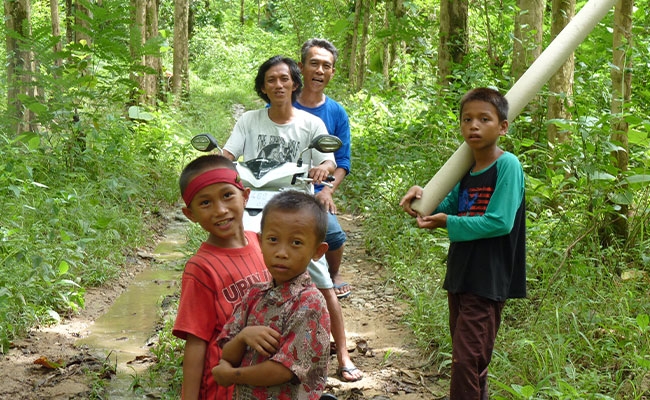Testing Theory: Uncovering What Makes Community Forestry Work
Packaging lessons learned from USAID ProLand’s work on community-based forestry enterprises
Published 09-11-20
Submitted by Tetra Tech

Tetra Tech’s Mark Donahue and Ian Deshmukh summarize the lessons learned from the U.S. Agency for International Development (USAID) Productive Landscape (ProLand) projects work with community-based forestry enterprises (CBFE).
This post originally ran on ClimateLinks.
Why do many CBFEs perform poorly even after years of donor and government investment? This was one of the questions that motivated a USAID ProLand project investigation into CBFEs as a strategy for improving land management. Although a few successful CBFEs receive a great deal of attention and publicity, the broad patterns we documented can inform project design and management across the developing world. We first conducted a global analysis of CBFEs using existing literature and key informants. We uncovered both elements common to successful CBFEs and lessons learned from the less successful ones. Building on this foundation, we produced a CBFE sourcebook to support USAID field staff and their partners. The sourcebook, introduced in this short video, walks users through key questions to inform decisions that any CBFE team needs to consider in order to establish realistic expectations, identify critical interventions, and maximize successful project outcomes.
Both the foundational assessment and the sourcebook focus on fundamental conditions required for successful CBFE development. To validate sourcebook applicability, our team visited three countries with differing levels of CBFE development: Mexico, Peru, and Indonesia. In each country, teams targeted advanced CBFEs and those facing challenges, and interviewed key forestry-sector actors from community members to the private sector and donors. With each field visit, we refined our understanding of CBFEs and what makes them work.
In Mexico, community forestry is recognized internationally as a success. Although the team validated the guidance for CBFE project design and management presented in the sourcebook, we were surprised to find that the extensive literature focuses on a handful of five-star Mexican CBFEs, and that there are hundreds of less successful examples. The exemplary cases have received large government and donor investment over decades, also known as subsidies. Considering the social and environmental benefits of the services provided by CBFE-protected forests—such as capturing and retaining carbon, protecting biodiversity, and regulating water—the value returned to society is likely greater than that of the subsidies.
Our Peru visit also validated the sourcebook’s suggested best forest management practices. The sourcebook concludes that CBFEs function best as social enterprises with their own management and operations team, overseen by existing communal governance structures. Within the small communities we visited, the community general assembly—responsible for many community functions—often carried out CBFE management. While CBFEs in these communities are currently functioning, if they take on more value chain activities, they will likely need to separate CBFE operations from the general community governance structures. We also learned that CBFEs in young and isolated Amazonian communities generally lack the interest or capacity to develop forest enterprises more advanced than contractual agreements with private-sector companies that buy, harvest, and sell the standing trees themselves.
In Indonesia, we found that most forest enterprises were not actual CBFEs because community managed forests and social benefits were absent. Since current government policies do not support communal forest management, these forest enterprises source timber from individual smallholders aggregated into cooperatives. Organizing timber supply from hundreds of dispersed woodlots requires capacities and financial resources beyond the reach of individual members. These cooperatives, typically dependent on non-governmental organization (NGO) partners, are exposed to a high risk of failure when business falters—or NGO support ends—since producers lack capacity to manage value chain functions beyond production.
While validating the applicability of the sourcebook to CBFE development, two features relevant to USAID program designers and managers stood out. First, community forest governance and enterprise capacity are critical, but are often not the focus of development interventions. Second, because CBFEs are social enterprises governed by and providing welfare and livelihood benefits to the whole community, established long-term partnerships between CBFEs and the public, private, and civil society sectors are essential for their success. CBFE program design should aim to help CBFEs navigate this evolving web of relationships and promote durable partnerships.
The sourcebook elaborates on these and other lessons. We are especially excited about the sourcebook’s guide to designing and implementing CBFE projects, designed as an operational resource for USAID field staff.

Tetra Tech
Tetra Tech
Tetra Tech is a leading provider of high-end consulting and engineering services for projects worldwide. With 27,000 associates working together, Tetra Tech provides clear solutions to complex problems in water, environment, sustainable infrastructure, renewable energy, and international development. We are Leading with Science® to provide sustainable and resilient solutions for our clients. For more information about Tetra Tech, please visit tetratech.com or follow us on LinkedIn and Facebook.
More from Tetra Tech

